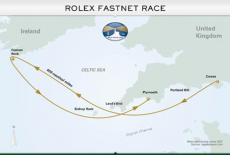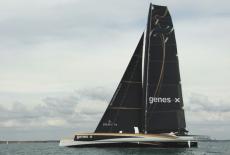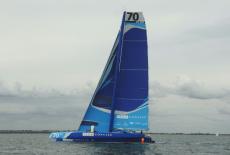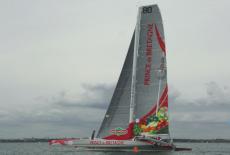Royal Ocean Racing Club - Rolex Fastnet Race

17.08.2015
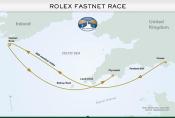
600 Mile Fastnet Race Course
On Sunday 16th August 2015 a record fleet of 356 yachts set off on the Rolex Fastnet Race, organised by the Royal Ocean Racing Club (RORC), with light winds forecast.
The classic Fastnet Race is one of sailing’s greatest contests and is the largest offshore race on the planet. The non-stop race course is 603 nautical miles (1116 kilometres).
The testing course passes several famous landmarks on the south coast of England. Initially, the race heads westward down The Solent, exiting into the English Channel at Hurst Castle. Yachts race around Lands End then sail across the Celtic Sea.
The legs across the Celtic Sea, to and from the Fastnet Rock, are long and unpredictable. Openly exposed to fast moving Atlantic weather systems the fleet often encounters the toughest weather of the race on its approach to and return from Ireland. In 1979 gale force winds and violent seas caused havoc as 18 lives were lost and less than a third of the fleet finished the race.
The symbol of this epic race is the Fastnet Rock, located off the southern coast of Ireland. Also known as the Teardrop of Ireland, the rock marks an evocative turning point for a challenging race. Boats then sail around the Scillies to finish in Plymouth.
The race attracts both professionals and amateurs, sailing the most diverse fleet of boats, from classic yachts to some of the fastest racing machines on the planet.
Course records for the 603 nautical miles Fastnet Race:
Multihull: 1 day, 8 hours, 48 minutes
Monohull: 1 day, 18 hours, 39 minutes
In 2015 over 25 countries are represented by boats and crews entered in the 46th edition of the biennial race.
Sunday 16 August: Start of 2015 Fastnet Race
On SUNDAY 16 AUGUST with a complete lack of wind in the central Solent the boats ghosted across the start line and headed down the English Channel, or La Manche as the French call this legendary stretch of water.
By early MONDAY 17 AUGUST the leading multihulls had passed Land's End and were tackling the south side of the Traffic Separation Scheme east of the Scillies. The larger 40 metre ‘Spindrift 2’ had edged into the lead overnight, but was only seven miles ahead of MOD70 ‘Phaedo’.
The multihull frontrunners then decided to take the most circuitous route. Rather than heading northwest at Land's End, they left the Scilly Isles to starboard, continuing due west into the strongest breeze before gybing north Monday afternoon with the wind building.
Here, in stark contrast to the rest of the race course, the wind was blowing 15 to 20 knots. By mid afternoon ‘Spindrift 2’, was eating up the miles, making 28 knots with some 37 miles to go to the Fastnet Rock. Behind her, the trio of MOD70s and the Multi 80 ‘Prince de Bretagne’ were only a knot or two slower.
Monday 17 August at 16.49 BST:
‘Spindrift 2’ rounds the Fastnet Rock
On TUESDAY 18 AUGUST a weak, dying front across southern Ireland and the Celtic Sea combined with an absence of isobars anywhere in the UK made it a frustrating night for the 350+ crews still competing in the Rolex Fastnet Race.
GRIB files for the race area show winds under 5 knots between the Fastnet Rock and Start Point. With a large hole in the breeze to the west ,where the multihulls and big monohulls were, and another hole between the Scilly Isles and the Lizard.
At the head of the fleet the usually speedy multihulls slow dramatically on their return journey from the Fastnet Rock, which they rounded Monday afternoon.
The world's fastest offshore race boat, the 40 metre trimaran 'Spindrift 2', leads the multihull fleet as they race from the Scilly Isles to the finish at Plymouth.
Tuesday 18 August at 22:57:41 BST:
'Spindrift 2' gets Multihull Line Honours - 2 days, 10 hours, 57 minutes
Fastnet Multihull Images: Copyright John Haynes
The Fastnet Race, which has taken place since 1925, was one of the earliest true tests of offshore sailing. It is legendary within the world of ocean racing. Flawless decision-making, determination and total commitment are the essential requirements as crews manage and anticipate the changing tidal and meteorological conditions imposed by the complex course.
FASTNET RACE RECORDS
The multihull race record was set in 2011 by French trimaran, 'Banque Populaire V' (now raced as 'Spindrift 2'), skippered by Loick Peyron with a total elapsed time of 32hrs, 48min and an average speed of 18.5 knots.
In 2011 the Volvo 70 'Abu Dhabi', skippered by British yachtsman and double Olympic medallist Ian Walker set a new monohull race record of 42 hours 39 minutes, proving that the bar is still capable of being moved.
DIVERSE FLEET
The diversity of the yachts and participants is truly extraordinary, with yachts ranging from 30 -140ft taking part on the same race course. The maxi trimaran ‘Spindrift 2’ is the holder of the Jules Verne Trophy for the fastest circumnavigation, sailing around the world in just over 45 days. New maxi monohulls such as100ft VPLP/Verdier design ‘Comanche’ and the JK 88 ‘Rambler will by racing alongside entrants in the new Classic Class, including the 1935 Fastnet Race winner 'Stormy Weather' of Cowes.
THE 1979 FASTNET
303 yachts started the Fastnet Race in 1979 , at that time the biggest fleet in the event’s history. Gale force winds and violent seas caused havoc as 18 lives were lost and less than a third of the fleet finished the race. After the 1979 Fastnet new regulations were introduced to improve the integrity of yacht design, make VHF radios mandatory plus eligibility qualifications were introduced for crews.
All images are copyright RIB & HSC 2024 unless otherwise stated.
This does not exclude the owner's assertion of copyright over the material.
05.04.2024
Hydro Motion - H2 from NL to England in 2024
The TU Delft Hydro Motion Team wants to cross to…
05.01.2024
The Challenges of Unpredictable Marine Energy
From military to superyacht, it is clear there is an urgent…
Speed@Seawork 2024
Dates:
10th June 2024
Location:
Cowes, Isle Of Wight,
Foiling and Flying RIBs
Foiling powerboat designed to meet military needs - fast, stable, silent, fuel-saving. Collaboration by SEAir Foiling Systems and Sillinger RIBs.…














